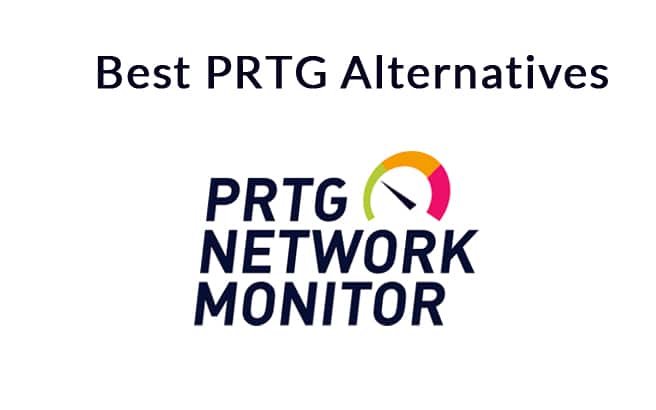This post will explain PRTG Alternatives Our Top 6 Monitoring Tools. Developed by the German business Paessler AG, the Paessler Router Traffic Grapher, or PRTG, is a well-known network monitoring tool. IT was introduced about 15 years ago as an upgrade to MRTG, the first and most well-known network monitoring tool. After fifteen years, there are already too many network monitoring products on the market. Many of them rival PRTG in quality. Even better are some of them.
Additionally, there are some open-source and free solutions available that rival PRTG in terms of features and excellence. We’re looking at PRTG alternatives today. You’ve arrived to the right location if you’re using PRTG now and want something better, or if you’ve heard of it and want to know what else is out there. Here are the top six PRTG alternatives that we could identify.
We’ll define PRTG and highlight its key characteristics before going over the alternatives. That will undoubtedly make it easier for us to weigh our alternatives. We’ll also do our best to define and describe network monitoring for you if you’re unfamiliar with it. You should now include a better understanding of the characteristics of the products under review. We’ll also go through the advantages of network monitoring tools in general if you’re still not persuaded.
PRTG Alternatives Our Top 6 Monitoring Tools
In this article, you can know about prtg alternatives here are the details below;
The six best PRTG alternatives that we could uncover will only be ready for review at that point. On our list, there is something for everyone with a mix of premium and free tools.
All of the products have intriguing features—some of them unique—that we’ll do our best to highlight, albeit none of them exactly match PRTG in terms of features.
What is PRTG, Exactly?
An agentless network monitoring system is what PRTG is, to put it briefly. It’s not necessary for any specialised software, known as an agent, to be operating on the systems being watched for agentless monitoring. Paessler Router Traffic Grapher is the acronym for PRTG, which is also a play on MRTG (the Multi Router Traffic Grapher), one of the original SNMP monitoring tools.
According to Paessler, PRTG has the quickest setup times of any monitoring product. It can be set up in a few minutes, claims the publisher. Due to its auto-discovery feature, which can scan your network for devices and add them to the tool automatically, it can take a little longer than two minutes to set up, but it’s still incredibly simple and quick. Following the conclusion of the auto-discovery, additional data about the discovered devices can be retrieved utilising a variety of communication protocols.
The system can interact via DICOM or the RESTful API in addition to using a combination of Ping, SNMP, WMI, NetFlow, jFlow, and sFlow. This tool is built using sensors that have been tailored for a particular need. There are HTTP and SMTP/POP3 (e-mail) application sensors, for instance. Additionally, there are sensors designed specifically for servers, switches, and routers.
PRTG offers more than 200 distinct preset sensors that can be utilized to gather data from the monitored devices, such as response times, processor, memory, database information, temperature, or system status. A variety of user interfaces are available from PRTG.
An Ajax-based web interface is the main one. Additionally, there are mobile apps for iOS & Android as well as a Windows corporate interface. The ability of the mobile apps to use push notifications for any alerts generated by PRTG is a good feature. There are also more conventional SMS or email notifications available. The server only functions on Windows, but any device with an Ajax-enabled browser can manage it.
Two versions of PRTG are accessible. There is a fully functional free version available, but it has a 100 sensor monitoring limit, with each monitored parameter counts as one sensor. For instance, monitoring two router interfaces counts as monitoring with two sensors. You must buy a licence if you want to use more than 100 sensors. 500 sensors cost $1600 as a starting point. A 30-day trial version that is fully functional, sensor-unlimited, and free is also available.
SNMP Monitoring Explained
The “S” in SNMP stands for “simple,” however the protocol is actually extremely complicated. However, you don’t need to be an expert in SNMP to use it, just like you don’t need to be an auto engineer to drive a car. It’s still beneficial to have a basic understanding of how it operates. SNMP is fundamentally a communication protocol that specifies how a management system for SNMP can read and write operational parameters in distant devices.
The terms for the parameters are OIDs, which stands for Object IDentifiers. The bytes out and bytes in counters are two OIDs that are particularly relevant when monitoring networking devices. As bytes are output or input, networking hardware automatically increments these counters. Each network interface has one such pair of counters. The SNMP protocol was created in an era before IT security became a concern. It only has little security as a result.
When connecting to a device that supports SNMP, an SNMP manager will send a “community string” along with the request. The request will be fulfilled if the string matches the one set up in the equipment. The two community strings that are generally present on devices are one for read-only OIDs and one for modifiable OIDs. Here is how a monitoring tool like PRTG employs SNMP to keep track of bandwidth usage.
The system periodically scans the interfaces’ bytes-in and-out counters at predetermined intervals. Devices are typically polled every five minutes. The monitoring system saves the retrieved values in a database or disc file of some kind. The remaining steps of the process only involve math. The number of bytes broadcast or received in five minutes is calculated by the monitoring system by subtracting the previous counter value from the current one.
The number can then be multiplied by eight to determine the number of bits, then it can be divided by 300 to determine the number of bits per second. Normally, this data is kept in a database and plotted on a graph to show how it has changed over time. The average use in bits per second over a five-minute period is what you receive out of this operation, which is a crucial point to keep in mind.
Imagine an interface of 100 Mbps. Even though the interface was at its maximum for half of the five minutes, the real traffic level could have fluctuated between 100 Mbps and 0 for 150 seconds in the five minutes between samples while still showing an average traffic of 50 Mbps. Each and every SNMP monitoring system has this flaw.
It won’t provide you with real-time, immediate utilisation data. Other methods can be used by some systems to obtain real-time traffic statistics, although they are uncommon. Most administrators’ needs can typically be met by five-minute averages.
Some Uses of Monitoring Tools
There are a number of situations when network monitoring tools like PRTG can be beneficial. It will first and foremost assist you in identifying points of dispute. Overused network circuits’ performance could and certainly will deteriorate. It goes without saying that you would want to prevent this.
Monitoring network bandwidth usage gives you the opportunity to see high usage—and address it—before it starts to impact consumers. Another significant benefit of network monitoring technologies is capacity planning.
It is common for network circuits, particularly long-distance WAN connections, to have a limited bandwidth that was deemed acceptable when they were first constructed.
But bandwidth requirements are constantly growing, much as disc storage.
You can determine which components of your network need to be improved and when by tracking the development of their bandwidth use.
When analysing bad application performance, network monitoring can be helpful.
If a user reports that a remote programme has slowed down, checking the network utilisation could help you determine whether or not network congestion is to blame.
If the network utilisation is modest, you should probably focus your troubleshooting efforts elsewhere.
Our top six PRTG Alternatives
Let’s examine the top six PRTG substitutes now on the market.
Our best tools come in both paid and free varieties.
Considering that all of our recommendations are top-notch goods, picking one over the other will primarily come down to personal preference.
Most paid programmes have a free trial, allowing you to determine for yourself whether they fulfil your needs.
1. SolarWinds Network Performance Monitor (FREE TRIAL)
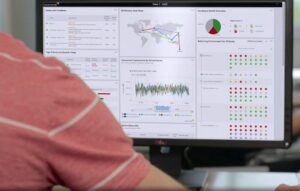
Network administrators seldom ever need an introduction to SolarWinds.
If you’re unaware, the business is renowned for its top-notch network administration solutions, which include a top-notch help desk management programme and one of the best switch port monitoring programmes.
In addition, SolarWinds is well known for its free tools that cater to particular needs.
For instance, they provide a very nice TFTP server and a great subnet calculator. Also check Spiceworks alternative
Network Performance Monitor, or NPM, is the company’s main offering.
It is an excellently functional full-featured network monitoring solution.
The SNMP protocol is used by the SolarWinds NPM to poll WAN routers and read their interface counters.
It uses the polled data to create graphs that display the consumption of each WAN circuit and maintains the results in a SQL database.
A device can be added to the SolarWinds Network Performance Monitor by simply entering its IP address or hostname and SNMP community string.
It then does a query on the device, displays a list of all the accessible SNMP parameters, and lets you choose which ones you wish to track and show on your graphs.
Although you might also include error counters, CPU and memory utilisation counters, and WAN interface traffic counters, you’ll be most interested in these for WAN monitoring.
The SolarWinds Network Performance Monitor costs vary depending on the digit of devices to be scanned and start at slightly under $2,995. This is another prtg alternatives.
The SolarWinds sales staff can be contacted for a comprehensive quote.
As with the majority of paid SolarWinds products, a free 30-day trial is offered if you’d like to preview the item before you buy.
2. ipMonitor
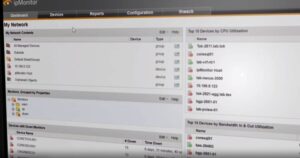
SolarWinds ® ipMonitor ® meets the need for a tool that is strong, yet portable and reasonably priced—especially in smaller environments.
In contrast, Network Performance Monitor offers scalability for bigger, more robust environments along with advanced troubleshooting and deeper network visibility.
ipMonitor is a centralised monitoring tool created to provide crucial up/down visibility into the performance of network devices, servers, and apps. It offers in-depth knowledge about the accessibility, utilisation, and performance of these crucial components.
It provides out-of-the-box configuration and doesn’t need an external database or web server.
Easy alerts, customised dashboards, built-in repair tools, and even user experience monitoring are additional benefits.
Tiers of pricing for ipMonitor are available, with prices starting at US$1,495 to meet various environments.
It has a licence for each monitor.
Ping, CPU, memory, disc use, bandwidth, response time, and environmental sensors are a few examples of monitors.
You can stretch it out for 14 days without paying anything, so you can decide later.
3. ManageEngine OpManager

Another reputable and well-known name in the industry is ManageEngine.
This is another prtg alternatives. Additionally, the ManageEngine OpManager is a premier product.
It has a tonne of great characteristics and can be used with either Windows or Linux. One of its auto-discovery functions can map your network and show it on the dashboard. Also check grooveshark alternative
The dashboard for the product is very simple to use and browse and features drill-down capabilities.
There are also apps for tablets and smartphones that will allow you to access the system from anywhere if you prefer them.
The ManageEngine OpManager is a highly polished and expertly made product overall.
The ManageEngine OpManager is offered in a free edition.
The number of devices you can monitor with it is restricted to ten.
Additionally, there are paid versions accessible through the Essential or Enterprise plans.
The first allows you to keep an eye on up to 1,000 nodes, while the second supports up to 10,000.
4. Cacti
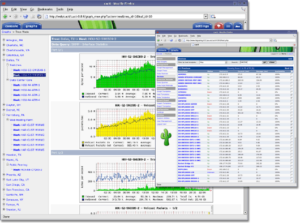
Cacti is a complete network monitoring tool that is open-source and free.
A quick poller, sophisticated graph templates, and various data collecting techniques make up its core parts.
User access control is another feature of Cacti that is included into the software.
The product has a web-based user interface that is simple to use but has an old-fashioned appearance.
From the smallest single device deployments up to complicated networks with numerous separate WAN sites, Cacti scales quite well.
Data is fetched by Cacti using SNMP and is kept in a SQL database.
It may be tailored to your needs and is mostly written in PHP.
The product’s utilisation of templates is one of its strongest aspects.
For Cisco routers, there are built-in templates that already include the majority of the components you might wish to monitor on such a device.
But there are also graph templates, in addition to device templates.
Together, templates simplify programme configuration. This is another prtg alternatives.
If there are no acceptable templates, you can also create your own unique ones.
Additionally, numerous device-specific templates are available for download on the websites of device manufacturers as well as numerous Cacti forums run by the community.
5. Observium
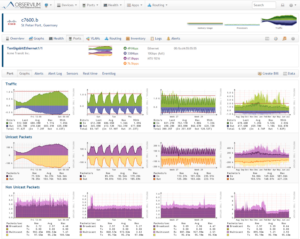
Observium is a monitoring platform with auto-discovery that requires little maintenance.
It works with a variety of hardware, software, and operating systems, including Cisco, Windows, Linux, HP, Juniper, Dell, FreeBSD, Brocade, Netscaler, and NetApp, among others. Also check alternatives to aim
You presumably won’t be capable to find a WAN router that is unsupported.
The main goal of Observium is to offer a stunning, simple, yet effective user interface that displays the health and state of your network.
There are two variations of the product.
There is the Observium Community, which is open to everyone and is free.
Twice a year, this edition is updated and given new features.
Also available is Observium Professional, which provides more features and receives regular updates.
Only Linux supports both versions.
Broadband monitoring is simply one feature of Observium.
This is another prtg alternatives. For instance, one accounting system measures total monthly bandwidth usage in terms of total transferred bytes or in the 95th percentile.
Additionally, it offers an alerting feature with programmable thresholds.
In addition, Observium interfaces with other systems and may access and show information from them.
Users of Observium adore how straightforward it is to place up and how nearly it can arrange itself.
Although Observium’s website doesn’t appear to have a download section, there are thorough installation instructions for a number of Linux distributions that do contain links to the appropriate download pages for each distribution.
The programme installation should be simple because the instructions are fairly detailed.
6. Zabbix
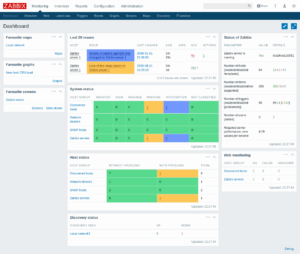
Another free and open-source product with a very polished appearance and feel, similar to what you’d expect from a commercial offering, is Zabbix. This is another prtg alternatives.
However, its user interface’s aesthetic appeal is not its only strength.
The product has an outstanding feature set, as well.
In addition to networking hardware, Zabbix can monitor the majority of network-attached devices.
If you want to monitor servers in addition to the bandwidth of your WAN route, this would be a fantastic alternative.
Zabbix monitors devices using SNMP and the Intelligent Platform Monitoring Interface (IMPI).
The app allows you to keep an eye on bandwidth, CPU and memory usage, overall device health, and configuration changes.
As you can see, it accomplishes far more than WAN monitoring alone.
The device also has a powerful alerting system that is fully customisable.
Not only will it send email or SMS notifications, but it will also execute local scripts that may be utilised to automatically resolve specific problems.
This list might have easily included ten items, if not more.
Although this does not imply that these are the only PRTG alternatives, it does indicate that we are confident in suggesting any of the items on the list.
In Conclusion
Every single one of them has some unique qualities and will perform flawlessly when used to monitor networks using SNMP.
None of them are inherently superior to the others, and one is best for you will primarily depend on your individual preferences and unique requirements.
Before choosing one, take a close look at the feature list of the items and test out a couple.
